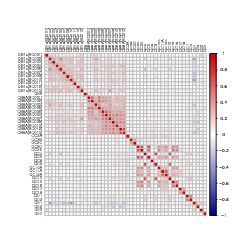Further plots
We have produced an autocorrelation plot to identify possible correlations between the answers provided to different questions. The plot is amenable to the following observations:
The questions in each group correlate positively with each other: respondents tend to be to the same degree concerned across the set of questions on advertisements, the questions on monopolies and the questions on Internet electronic democracy. This generally suggests coherence within each group of questions. However, in the group of questions of privacy such correlation is not so clear. Specifically, question QC2A does not correlate with the others in the group, while QC2B and QC2C correlate with each other and QC2D and QC2E again with each other.
Additionally, some other correlations can be observed.
Questions QC2D, QC2E (privacy) correlate positively with question QC5 (advertisements).
Questions QC2D, QC2E (privacy) correlate positively with questions QC10A, QC11B, QC12A (monopolies).
Questions QC2D, QC2E (privacy) correlate positively with questions QC15 (taxation) and QC16 (digital divide).
These correlations suggest that a respondent is likely to be to the same degree concerned about: the use of their data for profit-making (QC2D), the sharing of their personal data with other organisations (QC2E), their sharing of their personal data for advertising purposes (QC5), the monopoly character of the Internet (QC10A, QC11B, QC12A), the taxation avoidance of big companies (QC15) and the digital divide (QC16).
As expected, also:
Question QC5 (advertisements) correlates positively with questions QC10A, QC11B, QC12A (monopolies).
Question QC5 (advertisements) correlates positively with questions QC15 (taxation) and QC16 (digital divide).
Questions QC10A, QC11B, QC12A (monopolies) correlate positively with questions QC15 (taxation) and QC16 (digital divide).
Questions QC4, QC9, QC13, which are the questions on consideration of alternatives (for better privacy, less advertisements, less monopolies) correlate only with each other. This means that a respondent who considers alternatives is likely to do so to improve privacy, reduce advertising and reduce the monopoly character of the Internet. However, there is no correlation between the degree of concern expressed on any of these issues and the degree of consideration of alternatives to change the issue (privacy, advertisements, monopolies).
Questions QD1 and QD2 correlate with each other only. This means that a respondent who thinks there is a potential for community networks to resolve the concerns identifies is also likely to use such a community network. However, as there is no correlation between QD1/QD2 with any of the QC questions: this means that there is no link between the degree of concern on any of the issues and the degree of belief in/consideration of using community networks.
The questions on demographics present no correlation with any other questions. This means that there is no differentiation of the concerns expressed, or degree of considering alternative activities, according to any demographic factor (age, gender, occupation etc.).
| Title | Histogram thumb | Histogram (png) | Histogram (pdf) |
|---|---|---|---|
| extra Autocorrelation matrix |
 |
||
| extra Autocorrelation upper triangular matrix |
 |
||
| extra Heatmap |
 |

